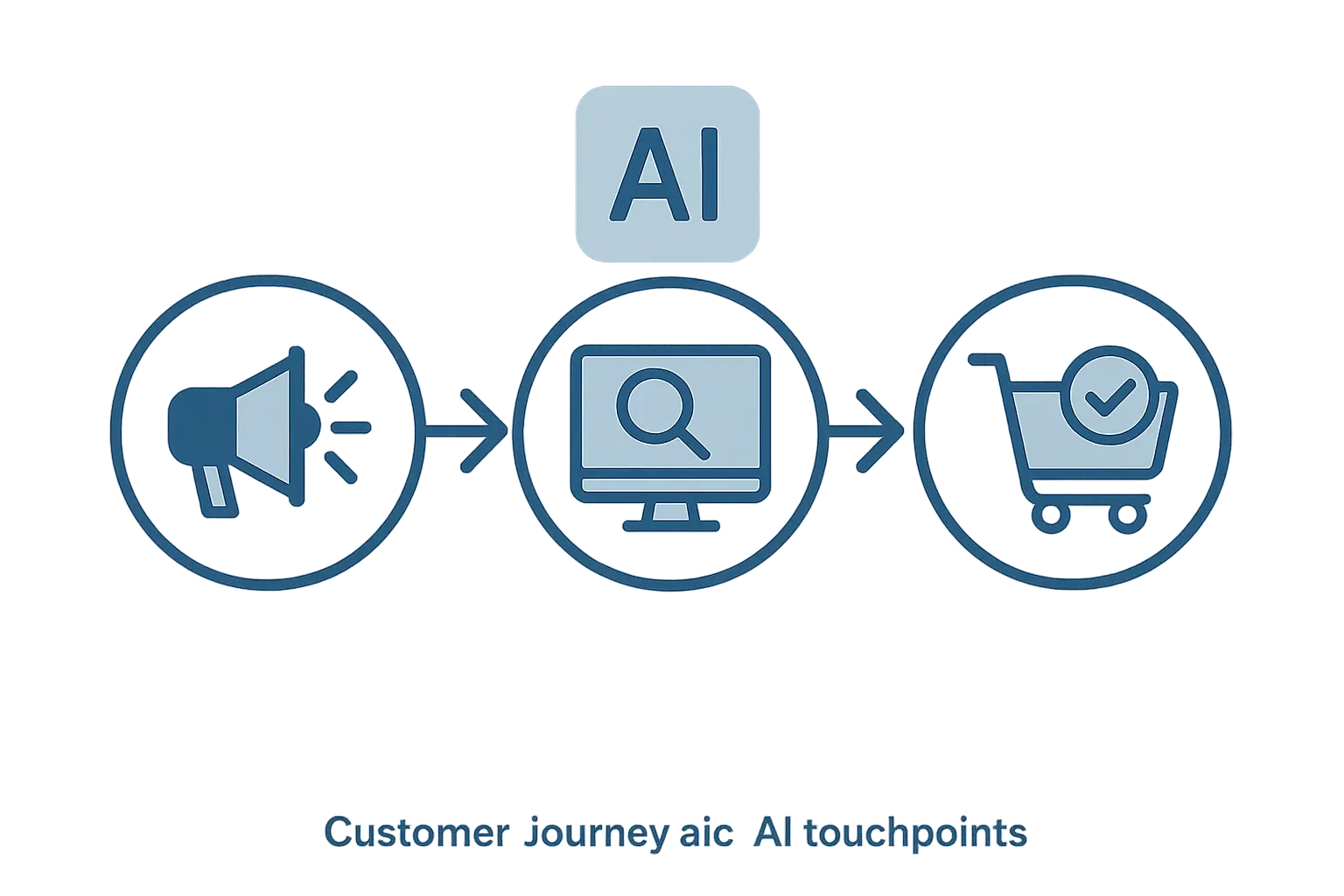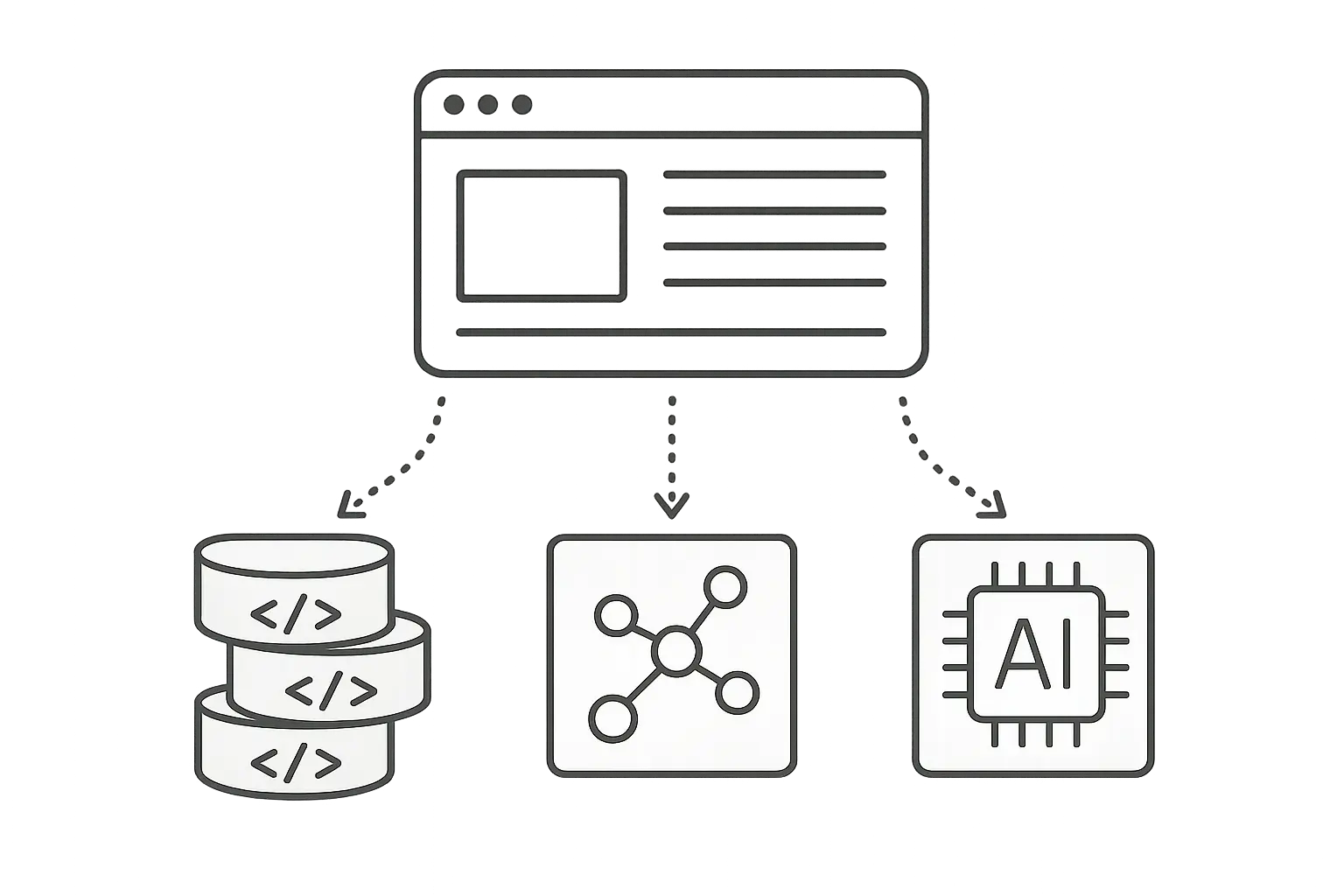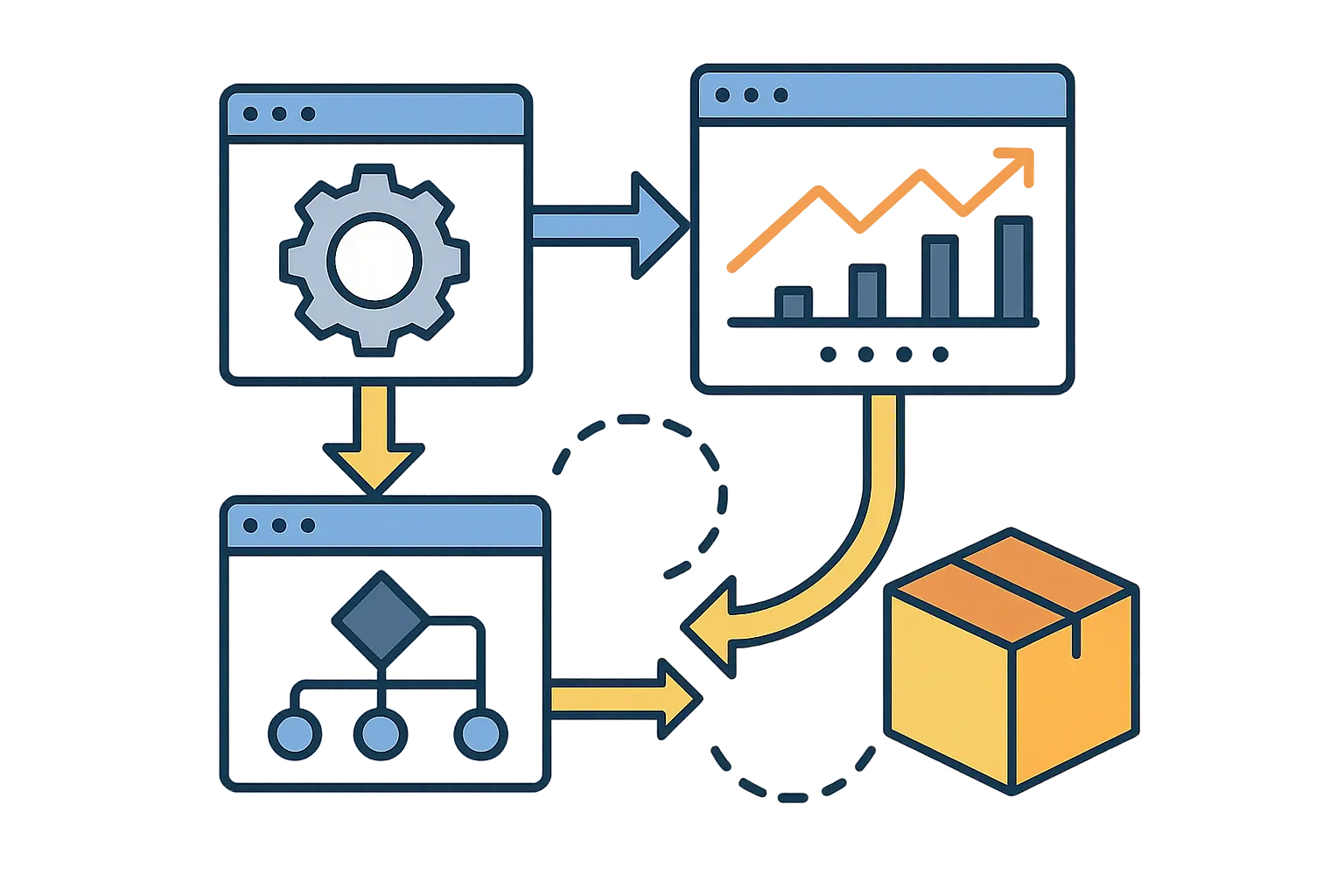Your customers aren’t Googling anymore. Well, not like they used to.
Last month, I watched a potential client research “best CRM software” using ChatGPT instead of Google. In 30 seconds, they got a personalized comparison with specific recommendations. Our client’s CRM? Nowhere to be found, despite ranking #3 for that exact keyword.
This isn’t a future problem – it’s happening right now. When someone asks AI about your industry, you’re either part of the answer or you’re invisible. There’s no middle ground.
Here’s something that might keep you up at night: Your potential customers are asking ChatGPT about your industry right now. And there’s a good chance your brand isn’t part of the conversation.
I learned this the hard way when a client told me they’d researched project management software using AI and never heard of us – despite us ranking #2 on Google for their main keyword. That’s when it hit me: we’re optimizing for yesterday’s search while our customers have already moved on to AI.
ChatGPT hit 100 million users faster than any app in history according to Semrush, demonstrating just how quickly this shift is happening. Generative engine optimization isn’t some distant marketing trend – it’s the reality of how people find solutions today.

The stakes are higher because AI responses often provide complete answers without sending users to your website. Your brand needs to establish authority within these AI-generated responses, not just hope for traffic. This represents a fundamental shift in how digital discovery works.
Modern businesses are discovering that traditional marketing strategies need significant adaptation to remain effective in this AI-driven landscape, particularly when it comes to digital marketing approaches that can capture attention across multiple platforms.
What Makes Generative Engine Optimization Different
Traditional SEO is about getting people to your website. Generative engine optimization is about being the expert AI systems quote when they answer questions.
Think of it this way: SEO gets you invited to the party. GEO makes you the person everyone wants to talk to once you’re there.
The big difference? Users might never visit your website but still choose you based on how AI presents your brand. I’ve seen companies get leads from prospects who say, “AI recommended you” – without ever clicking a single link.
Generative engine optimization encompasses every method you use to make your brand visible to AI systems. When ChatGPT answers a question about your industry, when Google’s SGE provides a summary, when Bing Chat makes recommendations – your optimization efforts determine whether you’re mentioned or ignored.
The scope extends beyond search engines to include any AI system that generates content or recommendations. Social media AI, shopping assistants, customer service bots – they all rely on similar underlying technologies that can reference your brand if you’ve optimized correctly.
Users increasingly expect immediate, comprehensive answers without leaving their current platform. They’re not looking to research across multiple websites – they want the AI to synthesize information and provide recommendations directly. Your brand needs to be part of that synthesis.
New research from Semrush predicts that LLM traffic will overtake traditional Google search by the end of 2027 according to Backlinko, highlighting the urgency of this transition.
Being mentioned authoritatively in an AI-generated answer can influence purchasing decisions without the user ever visiting your website. I’ve seen this firsthand – prospects mentioning our services during sales calls, having learned about us through AI interactions they barely remember.
Brand discovery increasingly happens within AI interfaces where users form opinions based on how authoritatively you’re presented. If competitors appear more prominently in AI responses, they gain significant advantages in perceived expertise and trustworthiness.

Lead generation patterns are changing as users make decisions based on AI recommendations without extensive independent research. Your generative engine optimization efforts directly influence whether you’re recommended, how you’re positioned relative to competitors, and what context surrounds your brand mentions.
GEO vs SEO: Why Your Current Strategy Isn’t Enough
Understanding the differences between geo vs seo is crucial for modern marketers. SEO assumes users will click through to your website where you can control their experience and guide them toward conversion. GEO operates in an environment where users may never leave the AI interface, requiring you to establish authority and influence within that contained experience.
This shift requires businesses to fundamentally rethink their approach to marketing strategy development to ensure they’re visible across both traditional search and AI-powered discovery methods.
|
What Changes |
Old Way (SEO) |
New Way (GEO) |
|---|---|---|
|
Goal |
Get clicks to your site |
Get mentioned by AI |
|
User behavior |
Clicks through multiple sites |
Gets complete answer from AI |
|
What matters |
Page rankings |
Being the trusted source AI quotes |
|
Success looks like |
High click-through rates |
AI recommends you over competitors |
|
Technical Focus |
Backlinks, page speed, crawlability |
Structured data, semantic markup, AI-readable formats |
|
Content Strategy |
Keyword-focused optimization |
Authoritative, conversational, AI-parseable content |
The technical requirements differ significantly. SEO relies heavily on backlinks, page speed, and crawlability. Generative engine optimization emphasizes structured data, semantic clarity, and content formats that large language models can easily parse and understand. Successful brands must master both seo and geo strategies simultaneously.
How User Journeys Have Changed
Customer research patterns have fundamentally changed. Instead of visiting multiple websites to compare options, users ask AI systems for recommendations and trust the synthesized responses. Your brand needs to influence these AI-generated recommendations to remain competitive.
Consider a user researching “best email marketing software for small business.” In traditional search, they might visit 5-10 websites, compare features, and read reviews. With AI search, they ask one question and receive a comprehensive comparison with recommendations. If your email marketing platform isn’t mentioned in that AI response, you’ve lost a potential customer without them ever knowing you exist.
Conversion paths now include AI-mediated touchpoints where users form opinions about your brand without visiting your website. These interactions can be more influential than traditional website visits because users perceive AI responses as objective and comprehensive.
Building Your Technical GEO Foundation
Here’s what actually matters for AI optimization:
Your technical foundation needs to serve both human users and AI systems effectively. This means implementing advanced schema markup, organizing content with clear hierarchies, and structuring information in ways that large language models can easily parse and reference.

The goal is making your content “AI-friendly” without sacrificing user experience or traditional search performance. This requires sophisticated technical strategies that address multiple algorithmic systems simultaneously.
Building this foundation requires expertise in both traditional web development and emerging AI technologies, making it essential to work with teams experienced in digital strategy implementation across multiple platforms and systems.
Make Your Content AI-Readable
AI systems are like really smart but literal students. They need clear, structured information. Instead of “We’re the leading provider of innovative solutions,” try “We’re the #1 rated email marketing platform for small businesses, used by 50,000+ companies.”
Large language models favor clearly organized information with logical hierarchies and explicit relationships between concepts. Your content structure should make it easy for AI to understand what you do, why you’re authoritative, and how you relate to other entities in your industry.
Research shows that pages with quotes or statistics have been shown to have 30-40% higher visibility in AI answers according to Backlinko. I tested this with a client’s pricing page. We added specific stats like ‘increases productivity by 35%’ instead of vague claims like ‘improves efficiency.’ Three months later, they were showing up in 40% more AI responses.
Structure That Works
Your information architecture should make it obvious to AI systems what topics you’re most authoritative about and how different pieces of content relate to each other. This helps ensure accurate representation when AI systems reference your expertise.
-
Use clear headings (AI loves organization)
-
Include specific stats and data points
-
Answer questions directly
-
Add schema markup (the technical stuff that helps AI understand your content)
Your schema implementation needs to explicitly define relationships between your brand, products, services, and industry concepts. AI systems use this structured data to understand how to position you relative to competitors and when to recommend your solutions.
The markup should include authority signals that AI systems recognize – things like credentials, certifications, awards, and expert associations. These elements help establish your credibility within the AI’s knowledge framework.
Content hierarchies need to be both human-readable and AI-parseable. This means using proper heading structures, clear topic organization, and explicit relationships between different pieces of information within your content ecosystem.
Content That AI Actually Understands
AI systems break content into chunks and analyze how those pieces relate to each other, similar to featured snippets but more granular. The way you structure your content directly impacts whether AI systems can understand and cite it effectively.

Modern AI content optimization focuses on creating information that serves both human readers and machine processing, requiring techniques that make content scannable, quotable, and contextually rich.
Successful content creation for AI systems requires understanding both traditional copywriting principles and emerging AI preferences, often benefiting from professional expertise in brand messaging development that resonates across multiple platforms.
Bad vs Good Content for AI
Bad for AI:
“Our cutting-edge platform leverages advanced algorithms to optimize your workflow efficiency.”
Good for AI:
“Our project management software reduces meeting time by 30% and helps teams complete projects 25% faster, based on data from 10,000+ users.”
See the difference? AI can quote the second example. The first one sounds like marketing fluff.
Instead of writing “Our software can help improve your business efficiency,” optimize for AI by stating “Our project management software increases team productivity by 35% on average, based on analysis of 10,000+ user accounts over 12 months.” The specific, verifiable claim with supporting data is much more likely to be referenced by AI systems.
Three Content Rules for AI
-
Be specific, not vague
-
Include numbers and timeframes
-
Answer questions people actually ask
Authority building becomes crucial for AI systems that prioritize credible sources. Ensure your content includes proper citations, expert credentials, and other signals that establish your expertise within your industry or niche.
Tools and Analytics for the New Search Reality
You need different tools to track AI mentions:
Monitoring your brand’s presence in AI-generated responses requires different tools than traditional SEO tracking. You need systems that can identify when and how your brand appears across multiple AI platforms, analyze the context of these mentions, and track changes over time.
Essential Tools
-
AI mention tracking – See when and how AI systems mention your brand
-
Content analysis tools – Check if your content is AI-friendly
-
Competitive monitoring – Track how often competitors appear in AI responses
These platforms continuously query AI systems with relevant prompts to track your brand mentions, analyze the context of these appearances, and monitor changes in how you’re represented. This data helps you understand your current AI visibility and identify optimization opportunities.

Competitive analysis becomes crucial when you can see how often competitors appear in AI responses compared to your brand. This intelligence helps you identify gaps in your generative engine optimization strategy and opportunities to improve your positioning.
AI-readability scoring helps you understand how well your content serves large language models. These tools analyze factors like semantic clarity, information hierarchy, and structured data implementation to provide actionable optimization recommendations.
What to Measure
-
How often AI mentions your brand
-
Whether the context is positive and accurate
-
Your position vs. competitors in AI responses
Tracking AI mentions requires different measurement approaches than traditional web analytics. You need systems that can identify indirect traffic from AI interactions, measure brand authority within AI responses, and track competitive positioning in generative search results.
Attribution modeling becomes more complex when users research through AI systems without visiting your website directly. Advanced analytics help connect AI mentions to eventual conversions and business outcomes.
Your Step-by-Step GEO Implementation Plan
Week 1-2: Test Your Current AI Visibility
Start by manually testing how your brand appears in AI responses across different platforms. Ask ChatGPT, Google AI, and Bing Chat about your industry. Take screenshots of every response. Note when you’re mentioned (or not mentioned).
Document your current AI visibility comprehensively. Note the context of mentions, accuracy of information, competitive positioning, and gaps where you should appear but don’t. This baseline becomes crucial for measuring improvement over time.
GEO Foundation Audit Checklist:
-
Test brand mentions across 5+ AI platforms (ChatGPT, Google SGE, Bing Chat, Perplexity, Claude)
-
Document current AI visibility context and accuracy
-
Identify competitor mentions in AI responses
-
Assess content structure for AI readability
-
Review existing schema markup implementation
-
Analyze gaps where brand should appear but doesn’t
-
Establish baseline metrics for future comparison
-
Prioritize quick-win optimization opportunities
Week 3-4: Quick Wins
-
Update your About page with specific credentials and stats
-
Add FAQ sections that answer common industry questions
-
Include more data points in your service descriptions
Identify quick optimization opportunities that can improve your AI visibility immediately. These might include updating your website’s schema markup, restructuring key content pages, or creating authoritative content that AI systems are likely to reference.
Month 2: Content Optimization
-
Rewrite key pages to be more AI-friendly
-
Create comprehensive guides on your main topics
-
Add structured data markup to important pages
Content restructuring should prioritize your most important pages and topics first. Implement proper heading hierarchies, add semantic markup, and organize information in ways that make it easy for AI systems to understand and reference accurately.
Create new content specifically designed for AI consumption. This includes comprehensive topic coverage, clear authority signals, and structured information that addresses common questions in your industry. Think about what AI systems need to recommend you confidently.
A software company restructured their pricing page by adding clear comparison tables, FAQ sections with structured data markup, and specific feature descriptions with quantifiable benefits. Within 3 months, they appeared 40% more frequently in AI responses about project management software pricing, leading to a 25% increase in qualified leads.
Month 3+: Scale and Monitor
-
Set up automated AI mention tracking
-
Create new content based on what AI systems are missing
-
Monitor competitors and find gaps you can fill
Automation helps you monitor AI mentions consistently without manual effort. Set up systems that regularly test your brand’s appearance in AI responses and alert you to significant changes in visibility or context.

Workflow integration ensures that generative engine optimization considerations become part of your standard content creation process. Train your team to think about AI optimization alongside traditional SEO when creating new content or updating existing materials.
Success requires coordinating multiple marketing disciplines simultaneously, making it valuable to work with teams experienced in comprehensive marketing campaign development that can integrate traditional and emerging optimization strategies effectively.
Advanced Tactics and Competitive Positioning
Prompt engineering research helps you understand exactly what queries trigger mentions of your brand or competitors. This intelligence guides content creation and optimization efforts by revealing the specific contexts where you need stronger positioning.
Competitive analysis in the AI space requires monitoring how often competitors appear in relevant AI responses and analyzing the context of their mentions. This helps identify opportunities to improve your relative positioning.
Strategic partnerships can boost your authority signals within AI systems. Collaborations with recognized experts, citations from authoritative sources, and mentions in industry publications all contribute to how AI systems perceive your credibility.
|
GEO Tactic |
Implementation |
Expected Timeline |
Success Metrics |
|---|---|---|---|
|
Schema Markup Enhancement |
Add structured data to key pages |
2-4 weeks |
Improved AI content parsing |
|
Content Restructuring |
Reorganize with clear hierarchies |
4-8 weeks |
Higher AI citation frequency |
|
Authority Signal Building |
Secure expert mentions and citations |
8-12 weeks |
Increased trust indicators |
|
Multi-Platform Presence |
Expand to Reddit, YouTube, LinkedIn |
6-10 weeks |
Broader AI source diversity |
|
Competitive Analysis |
Monitor competitor AI mentions |
Ongoing |
Relative positioning insights |
|
Automated Monitoring |
Set up AI mention tracking tools |
2-3 weeks |
Consistent visibility data |
Measuring Success in an AI-First World
Forget traditional metrics for a moment. Here’s what actually matters:
Success measurement in generative engine optimization focuses on influence and authority within AI responses rather than traditional metrics like click-through rates and rankings. You need to track how often you’re mentioned, the quality of context surrounding these mentions, and your competitive positioning.
Attribution becomes more complex when users research through AI systems without visiting your website directly. Advanced measurement helps connect AI mentions to business outcomes and ROI, even when the connection isn’t immediately obvious.
AI Mention Frequency
How often do AI systems mention your brand when discussing your industry? Track this monthly.
Tracking AI-influenced conversions requires sophisticated attribution modeling that accounts for indirect influence. Users might research through AI systems, then visit your website later through direct navigation or other channels.
Lead attribution should account for AI touchpoints in the customer journey. Survey new leads about their research process to understand how AI interactions influenced their decision-making and eventual conversion.
Context Quality
Are you mentioned as the expert, or just another option? Quality beats quantity.
Authority measurement focuses on the quality and context of your AI mentions rather than just frequency. Track whether you’re presented as an expert, how often you’re recommended over competitors, and the accuracy of information AI systems share about your brand.
Context analysis reveals how AI systems position your brand relative to competitors and industry topics. Are you mentioned as a leader, alternative option, or niche specialist? This positioning directly influences user perceptions and decision-making.

Competitive Position
When AI lists competitors, where do you rank? Are you included at all?
Trust signals within AI responses include how confidently systems recommend you and whether they cite specific credentials or achievements. These elements indicate how well your authority-building efforts are resonating with AI algorithms.
Real Example:
A client went from zero AI mentions to appearing in 60% of relevant AI responses within 6 months. Their lead quality improved because prospects already viewed them as the expert before making contact.
Revenue attribution helps justify generative engine optimization investments by connecting AI visibility to business outcomes. This might involve tracking brand searches that follow AI interactions or monitoring conversion rate improvements correlated with increased AI mentions.
Future-Proofing Your Brand’s AI Visibility
Three Rules for Staying Ahead:
-
Diversify platforms – Don’t put all your eggs in the ChatGPT basket
-
Stay flexible – AI platforms change fast; be ready to adapt
-
Focus on authority – Build real expertise that any AI system would want to reference
Platform diversity is increasing as new AI systems launch regularly, each with unique optimization requirements and opportunities for early-mover advantages. Your strategy needs flexibility to adapt to these emerging platforms while maintaining consistency across existing ones.
Algorithm changes in AI systems can significantly impact your visibility overnight. Building robust, diversified optimization approaches helps protect against sudden shifts in any single platform’s behavior or preferences.
Future-proofing requires staying current with emerging technologies and platforms, often benefiting from partnerships with agencies experienced in innovative design approaches that can adapt to new interface paradigms and user expectations.
What’s Coming Next
-
More AI platforms launching regularly
-
Voice search integration with AI responses
-
AI shopping assistants that make purchase recommendations
-
Industry-specific AI tools that need to know about your expertise
Early adoption advantages are significant in the AI space because fewer brands are competing for visibility on new platforms. Getting established before your competitors can provide lasting benefits as these platforms grow their user bases.
Platform-specific optimization becomes necessary as different AI systems develop unique preferences and algorithms. What works for ChatGPT might not work for Google’s SGE or emerging platforms, requiring tailored approaches for each system.
Multi-Platform Optimization Strategy
Consistency across platforms ensures your brand message remains coherent regardless of where users encounter you. While optimization tactics might vary, your core value proposition and authority signals should remain consistent across all AI systems. Integrating seo and geo strategies helps maintain this consistency while serving different algorithmic preferences.
Efficiency in multi-platform optimization comes from identifying common elements that work across different AI systems while customizing specific aspects for each platform’s unique requirements and preferences.
Testing and iteration help you understand what works best for each platform without making assumptions. Regular experimentation reveals platform-specific opportunities and helps you stay ahead of algorithm changes.

How can The Marketing Agency help you navigate this complex transition? We’ve developed specialized generative engine optimization services that combine our data-driven approach with cutting-edge AI optimization techniques. Our team monitors AI mentions across platforms, optimizes content for large language model visibility, and tracks the metrics that actually matter in this new landscape.
We understand that you can’t abandon traditional SEO while building for AI – that’s why our integrated approach ensures you maintain current performance while preparing for the future. Ready to ensure your brand stays visible as search continues evolving? Our generative engine optimization expertise can protect and grow your digital presence in the age of AI.
The Bottom Line
Your customers are already using AI to research solutions in your industry. The question isn’t whether this trend will continue – it’s whether you’ll be part of the conversation.
The shift toward AI-powered search isn’t coming – it’s already here. Every day that passes without generative engine optimization is a day your competitors might be building advantages that become harder to overcome. The good news? Most brands haven’t figured this out yet, which means early movers still have significant opportunities.
Success in this new landscape requires balancing proven SEO strategies with experimental generative engine optimization tactics. You can’t abandon what’s working, but you also can’t ignore where search behavior is heading. The brands that master this balance will dominate their industries as AI becomes the primary interface for information discovery.
Start small. Test your current AI visibility. Make a few content updates. Track what changes. You don’t need to revolutionize everything overnight, but you do need to start.
Because while you’re debating whether generative engine optimization matters, your competitors might be building relationships with the AI systems that will recommend solutions to your future customers.
The good news? Most brands haven’t figured this out yet. But that window won’t stay open forever.
Ready to Get Started?
Pick one AI platform. Ask it five questions about your industry. See what happens. That’s your starting point.
Everything else is just execution.



